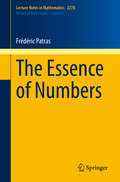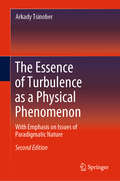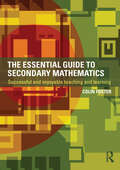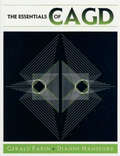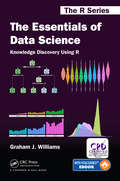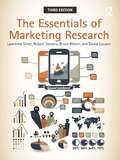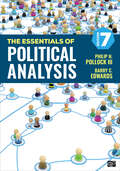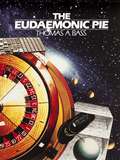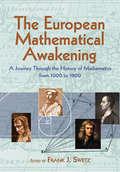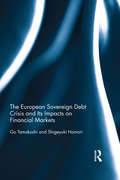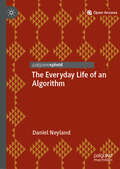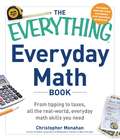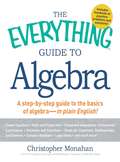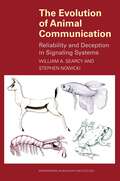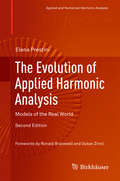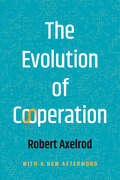- Table View
- List View
The Essence of Numbers (Lecture Notes in Mathematics #2278)
by Frédéric PatrasThis book considers the manifold possible approaches, past and present, to our understanding of the natural numbers. They are treated as epistemic objects: mathematical objects that have been subject to epistemological inquiry and attention throughout their history and whose conception has evolved accordingly. Although they are the simplest and most common mathematical objects, as this book reveals, they have a very complex nature whose study illuminates subtle features of the functioning of our thought. Using jointly history, mathematics and philosophy to grasp the essence of numbers, the reader is led through their various interpretations, presenting the ways they have been involved in major theoretical projects from Thales onward. Some pertain primarily to philosophy (as in the works of Plato, Aristotle, Kant, Wittgenstein...), others to general mathematics (Euclid's Elements, Cartesian algebraic geometry, Cantorian infinities, set theory...). Also serving as an introduction to the works and thought of major mathematicians and philosophers, from Plato and Aristotle to Cantor, Dedekind, Frege, Husserl and Weyl, this book will be of interest to a wide variety of readers, from scholars with a general interest in the philosophy or mathematics to philosophers and mathematicians themselves.
The Essence of Turbulence as a Physical Phenomenon: With Emphasis On Issues Of Paradigmatic Nature
by Arkady TsinoberNow in its second edition, this book clearly, concisely and comprehensively outlines the essence of turbulence. In view of the absence of a theory based on first principles and adequate tools to handle the problem, the “essence” of turbulence, i.e. what turbulence really is from a fundamental point of view, is understood empirically through observations from nature, laboratories and direct numerical simulations rather than explained by means of conventional formalistic aspects, models, etc., resulting in pertinent issues being described at a highly theoretical level in spite of the mentioned lack of theory.As such, the book highlights and critically reexamines fundamental issues, especially those of paradigmatic nature, related to conceptual and problematic aspects, key misconceptions and unresolved matters, and discusses why the problem is so difficult. As in the previous edition, the focus on fundamental issues is also a consequence of the view that without corresponding advances in fundamental aspects there is little chance of progress in any applications. More generally there is a desperate need for physical fundamentals of a great variety of processes in nature and technology in which turbulence plays a central role. Turbulence is omnipresent throughout the natural sciences and technology, but despite the vast sea of information available the book retains its brevity without oversimplifications, making it of interest to a broad audience.
The Essential Guide to Effect Sizes: Statistical Power, Meta-analysis, and the Interpretation of Research Results
by Paul D. EllisThis succinct and jargon-free introduction to effect sizes gives students and researchers the tools they need to interpret the practical significance of their results. Using a class-tested approach that includes numerous examples and step-by-step exercises, it introduces and explains three of the most important issues relating to the practical significance of research results: the reporting and interpretation of effect sizes (Part I), the analysis of statistical power (Part II), and the meta-analytic pooling of effect size estimates drawn from different studies (Part III). The book concludes with a handy list of recommendations for those actively engaged in or currently preparing research projects.
The Essential Guide to Secondary Mathematics: Successful and enjoyable teaching and learning
by Colin FosterCombining research-based theory with fresh, practical guidance for the classroom, The Essential Guide to Secondary Mathematics is a stimulating new resource for all student and practising teachers looking for new ideas and inspiration. With an emphasis on exciting your mathematical and pedagogical passions, it focuses on the dynamics of the classroom and the process of designing and using rich mathematical tasks. Written by a highly experienced mathematics teacher who understands the realities of the secondary classroom, this book combines insights from the latest research into mathematical learning with useful strategies and ideas for engaging teaching. The text is punctuated by frequent tasks, some mathematical and others more reflective, which are designed to encourage independent thinking. Key topics covered include: Preparing yourself: thinking about mathematics and pedagogy, taking care of your health and dealing with stress Different styles of learning and teaching mathematics Ideas for lessons: what does it take to turn an idea into a lesson? Tasks, timings and resources Equality and dealing positively with difference Mathematical starters, fillers and finishers: achieving variety The mathematical classroom community: seating layouts, displays and practical considerations Assessment: effective strategies for responding to learners‘ mathematics and writing reports. The Essential Guide to Secondary Mathematics will be a valuable resource both for beginning teachers interested in developing their understanding, and for experienced teachers looking to re-evaluate their practice. Aiming to develop all aspects of your mathematics teaching, this book will help you to devise, adapt and implement ideas for successful and enjoyable teaching and learning.
The Essential R Reference
by Mark GardenerAn essential library of basic commands you can copy and paste into RThe powerful and open-source statistical programming language R is rapidly growing in popularity, but it requires that you type in commands at the keyboard rather than use a mouse, so you have to learn the language of R. But there is a shortcut, and that's where this unique book comes in. A companion book to Visualize This: The FlowingData Guide to Design, Visualization, and Statistics, this practical reference is a library of basic R commands that you can copy and paste into R to perform many types of statistical analyses.Whether you're in technology, science, medicine, business, or engineering, you can quickly turn to your topic in this handy book and find the commands you need.Comprehensive command reference for the R programming language and a companion book to Visualize This: The FlowingData Guide to Design, Visualization, and StatisticsCombines elements of a dictionary, glossary, and thesaurus for the R languageProvides easy accessibility to the commands you need, by topic, which you can cut and paste into R as neededCovers getting, saving, examining, and manipulating data; statistical test and math; and all the things you can do with graphsAlso includes a collection of utilities that you'll find usefulSimplify the complex statistical R programming language with The Essential R Reference..
The Essentials of Biostatistics for Physicians, Nurses, and Clinicians
by Michael R. ChernickA fundamental and straightforward guide to using and understanding statistical concepts in medical researchDesigned specifically for healthcare practitioners who need to understand basic biostatistics but do not have much time to spare, The Essentials of Biostatistics for Physicians, Nurses and Clinicians presents important statistical methods used in today's biomedical research and provides insight on their appropriate application. Rather than provide detailed mathematics for each of these methods, the book emphasizes what healthcare practitioners need to know to interpret and incorporate the latest biomedical research into their practices.The author draws from his own experience developing and teaching biostatistics courses for physicians and nurses, offering a presentation that is non-technical and accessible. The book begins with a basic introduction to the relationship between biostatistics and medical research, asking the question "why study statistics?," while also exploring the significance of statisitcal methods in medical literature and clinical trials research. Subsequent chapters explore key topics, including:Correlation, regression, and logistic regressionDiagnosticsEstimating means and proportionsNormal distribution and the central limit theoremSampling from populationsContingency tablesMeta-analysisNonparametric methodsSurvival analysisThroughout the book, statistical methods that are often utilized in biomedical research are outlined, including repeated measures analysis of variance, hazard ratios, contingency tables, log rank tests, bioequivalence, cross-over designs, selection bias, and group sequential methods. Exercise sets at the end of each chapter allow readers to test their comprehension of the presented concepts and techniques.The Essentials of Biostatistics for Physicians, Nurses, and Clinicians is an excellent reference for doctors, nurses, and other practicing clinicians in the fields of medicine, public health, pharmacy, and the life sciences who need to understand and apply statistical methods in their everyday work. It also serves as a suitable supplement for courses on biostatistics at the upper-undergraduate and graduate levels.
The Essentials of CAGD
by Gerald Farin Dianne HansfordPutting the G into CAGD, the authors provide a much-needed practical and basic introduction to computer-aided geometric design. This book will help readers understand and use the elements of computer-aided geometric design, curves and surfaces, without the mathematical baggage that is necessary only for more advanced work. Though only minimal backg
The Essentials of Data Science: Knowledge Discovery Using R (Chapman & Hall/CRC The R Series)
by Graham J. Williams<p>The Essentials of Data Science: Knowledge Discovery Using R presents the concepts of data science through a hands-on approach using free and open source software. It systematically drives an accessible journey through data analysis and machine learning to discover and share knowledge from data. <p>Building on over thirty years’ experience in teaching and practising data science, the author encourages a programming-by-example approach to ensure students and practitioners attune to the practise of data science while building their data skills. Proven frameworks are provided as reusable templates. Real world case studies then provide insight for the data scientist to swiftly adapt the templates to new tasks and datasets. <p>The book begins by introducing data science. It then reviews R’s capabilities for analysing data by writing computer programs. These programs are developed and explained step by step. From analysing and visualising data, the framework moves on to tried and tested machine learning techniques for predictive modelling and knowledge discovery. Literate programming and a consistent style are a focus throughout the book.</p>
The Essentials of Marketing Research
by Bruce Wrenn Lawrence Silver David L. Loudon Robert E. StevensIdentifying and assessing the ways in which changes in the marketing mix affect consumer behavior is key to a successful marketing strategy. The Essentials of Marketing Research guides the student in designing, conducting and interpreting marketing research. This comprehensive textbook covers the full range of topics, including: Secondary research and data mining Internet marketing research Qualitative and exploratory research Statistical analysis Marketing research ethics With learning objectives at the beginning of each chapter, a host of cases and a comprehensive companion website, this book offers a range of tools to help students develop and test their research and analytical skills.
The Essentials of Political Analysis
by Philip H. Pollock Barry Clayton EdwardsEquip students with the skills and confidence they need to conduct political analyses and critically assess statistical research. In the Seventh Edition of The Essentials of Political Science, bestselling authors Philip H. Pollock III and Barry C. Edwards build students’ analytic abilities and develop their statistical reasoning with new data, fresh exercises, and clear examples. This brief and reader-friendly guide walks students through the essentials— defining measurement, formulating and testing hypotheses, measuring variables—while using key terms, chapter-opening objectives, over 80 tables and figures, and practical exercises to get them using and applying their new skills. Using Excel, R, SPSS, or STATA? Companion workbooks featuring statistical software instructions and exercises help your students apply their knowledge.
The Essentials of Political Analysis
by Philip H. Pollock Barry Clayton EdwardsEquip students with the skills and confidence they need to conduct political analyses and critically assess statistical research. In the Seventh Edition of The Essentials of Political Science, bestselling authors Philip H. Pollock III and Barry C. Edwards build students’ analytic abilities and develop their statistical reasoning with new data, fresh exercises, and clear examples. This brief and reader-friendly guide walks students through the essentials— defining measurement, formulating and testing hypotheses, measuring variables—while using key terms, chapter-opening objectives, over 80 tables and figures, and practical exercises to get them using and applying their new skills. Using Excel, R, SPSS, or STATA? Companion workbooks featuring statistical software instructions and exercises help your students apply their knowledge.
The Eudaemonic Pie
by Thomas A BassThe Eudaemonic Pie is the bizarre true story of how a band of physicists and computer wizards took on Las Vegas.
The European Mathematical Awakening: A Journey Through the History of Mathematics from 1000 to 1800
by Frank J. SwetzAbsorbing and entertaining, these thirty-two articles by distinguished educators offer a reader-friendly introduction to the history of mathematics. The newly corrected and updated essays cover eight centuries of discoveries, ranging from the medieval practice of finger calculus to the pioneering work of Leonhard Euler.Fascinating topics include the geometry behind the windows of Gothic churches, the development of complex numbers, the evolution of algebraic symbolism, and mathematical considerations on the trajectory of a cannon ball. Profiles of historic figures include Leonardo Fibonacci, Johannes Kepler, Isaac Newton, Galileo, the Bernoulli family, and other well- and less-known personalities, including mathematicians of the French Revolution and women in mathematics. Suitable for readers with no background in mathematics, this volume offers an excellent guide for high school students and college undergraduates as well as anyone with an interest in the history of mathematics.
The European Sovereign Debt Crisis and Its Impacts on Financial Markets
by Shigeyuki Hamori Go TamakoshiThe global financial crisis saw many Eurozone countries bearing excessive public debt. This led the government bond yields of some peripheral countries to rise sharply, resulting in the outbreak of the European sovereign debt crisis. The debt crisis is characterized by its immediate spread from Greece, the country of origin, to its neighbouring countries and the connection between the Eurozone banking sector and the public sector debt. Addressing these interesting features, this book sheds light on the impacts of the crisis on various financial markets in Europe. This book is among the first to conduct a thorough empirical analysis of the European sovereign debt crisis. It analyses, using advanced econometric methodologies, why the crisis escalated so prominently, having significant impacts on a wide range of financial markets, and was not just limited to government bond markets. The book also allows one to understand the consequences and the overall impact of such a debt crisis, enabling investors and policymakers to formulate diversification strategies, and create suitable regulatory frameworks.
The Everyday Life of an Algorithm
by Daniel NeylandThis open access book begins with an algorithm–a set of IF…THEN rules used in the development of a new, ethical, video surveillance architecture for transport hubs. Readers are invited to follow the algorithm over three years, charting its everyday life. Questions of ethics, transparency, accountability and market value must be grasped by the algorithm in a series of ever more demanding forms of experimentation. Here the algorithm must prove its ability to get a grip on everyday life if it is to become an ordinary feature of the settings where it is being put to work. Through investigating the everyday life of the algorithm, the book opens a conversation with existing social science research that tends to focus on the power and opacity of algorithms. In this book we have unique access to the algorithm’s design, development and testing, but can also bear witness to its fragility and dependency on others.
The Everything Everyday Math Book: From Tipping to Taxes, All the Real-World, Everyday Math Skills You Need
by Christopher MonahanAll the math basics you'll ever need!It's not too late to learn practical math skills! You may not need to use quadratic equations very often, but math does play a large part in everyday life. On any given day, you'll need to know how long a drive will take, what to tip a waiter, how large a rug to buy, and how to calculate a discount. With The Everything Everyday Math Book, you'll get a refresher course in all the basics you need, including:Adding and subtracting fractionsUnderstanding percentagesUsing ratiosFinding area and perimeter You'll the learn formulas and shortcuts to help in hundreds of everyday situations, from budgeting and paying bills to shopping, redecorating, preparing taxes, and evaluating loans and other financial instruments. With this easy-to-follow guide, you'll never get stuck on a math problem again!
The Everything Guide to Algebra
by Christopher MonahanWhether you need help solving equations or determining the slope of a line, this guide gives you the tools you need to find your answers! Beginning with the basics, you will learn and practice all the skills needed to enhance your algebra expertise.This comprehensive guide covers all the key concepts, including:Variables and expressionsLinear equations and inequalitiesMonomials and polynomialsExponentsRational expressionsThe Pythagorean theoremArea and perimeterGraphs and chartsInside you'll find hundreds of examples to illustrate the basics and plenty of exercises to ensure mastery of these fundamentals. No matter if you're a student looking for a companion to your textbook, or a curious learner who's been away from the classroom too long, this will be your indispensable algebra primer.
The Everything Guide to Algebra: A Step-by-Step Guide to the Basics of Algebra - in Plain English!
by Christopher MonahanWhether you need help solving equations or determining the slope of a line, this guide gives you the tools you need to find your answers! Beginning with the basics, you will learn and practice all the skills needed to enhance your algebra expertise.This comprehensive guide covers all the key concepts, including:Variables and expressionsLinear equations and inequalitiesMonomials and polynomialsExponentsRational expressionsThe Pythagorean theoremArea and perimeterGraphs and charts Inside you'll find hundreds of examples to illustrate the basics and plenty of exercises to ensure mastery of these fundamentals. No matter if you're a student looking for a companion to your textbook, or a curious learner who's been away from the classroom too long, this will be your indispensable algebra primer.
The Everything Guide to Pre-Algebra
by Jane CassieMaster the building blocks of mathematics! Not everyone is born a math whiz. Sometimes, all you need is a little extra help and practice to improve your comprehension. If you're a student encountering complex math for the first time, a parent wanting to help with homework, or an adult returning to school, The Everything Guide to Pre-Algebra is perfect for you. This essential guide uses simple explanations, step-by-step examples, and lots of review exercises to cover all the pre-algebra basics, including: Rational and irrational numbers Fractions, decimals, and percents Variables and functions Expressions and equations Number properties Inequalities Absolute values Plane geometry With unique study strategies and proven test-taking tips, The Everything Guide to Pre-Algebra will help boost your math knowledge--and your confidence--one right answer at a time.
The Everything Parent's Guide to Common Core Math Grades 6-8: Understand the New Math Standards to Help Your Child Learn and Succeed
by Jamie L SiroisTake the mystery out of Common Core math!The Common Core, a new set of national educational standards, has been adopted by forty-five states across the nation. But if you learned math the "old" way, the new teaching methods--like tape diagrams, array models, and number bonds--may be unfamiliar to you. If you want to help your children with homework, you'll need to learn these new methods, which focus on critical thinking and conceptual understanding.With the help of experienced math teachers, you'll learn:What your child will be learning in each middle-school gradeThe rationale behind the Common Core standardsMultiple new ways to look at math problemsHow to help your child with homework and studyingThe Everything Parent's Guide to Common Core Math: Grades 6-8 features examples and exercises that correspond to each standard, so you'll have the confidence you need to help your kids succeed and thrive in the new school standards.
The Evolution of Animal Communication: Reliability and Deception in Signaling Systems (Monographs in Behavior and Ecology #30)
by Stephen Nowicki William A. SearcyGull chicks beg for food from their parents. Peacocks spread their tails to attract potential mates. Meerkats alert family members of the approach of predators. But are these--and other animals--sometimes dishonest? That's what William Searcy and Stephen Nowicki ask in The Evolution of Animal Communication. They take on the fascinating yet perplexing question of the dependability of animal signaling systems. The book probes such phenomena as the begging of nesting birds, alarm calls in squirrels and primates, carotenoid coloration in fish and birds, the calls of frogs and toads, and weapon displays in crustaceans. Do these signals convey accurate information about the signaler, its future behavior, or its environment? Or do they mislead receivers in a way that benefits the signaler? For example, is the begging chick really hungry as its cries indicate or is it lobbying to get more food than its brothers and sisters? Searcy and Nowicki take on these and other questions by developing clear definitions of key issues, by reviewing the most relevant empirical data and game theory models available, and by asking how well theory matches data. They find that animal communication is largely reliable--but that this basic reliability also allows the clever deceiver to flourish. Well researched and clearly written, their book provides new insight into animal communication, behavior, and evolution.
The Evolution of Applied Harmonic Analysis
by Elena PrestiniA sweeping exploration of essential concepts and applications in modern mathematics and science through the unifying framework of Fourier analysis! This unique, extensively illustrated monograph describes the evolution of harmonic analysis, integrating theory and applications in a way that requires only some general mathematical sophistication and knowledge of calculus in certain sections. Key features: * Historical sections interwoven with key scientific developments showing how, when, where, and why harmonic analysis evolved * Exposition driven by more than 150 illustrations and numerous examples * Concrete applications of harmonic analysis to signal processing, computerized music, Fourier optics, radio astronomy, crystallography, CT scanning, nuclear magnetic resonance imaging and spectroscopy * Includes a great deal of material not found elsewhere in harmonic analysis books * Accessible to specialists and non-specialists * Contains new chapters on the fast Fourier transform, atmospheric physics, and climate change The Evolution of Applied Harmonic Analysis, 2nd ed. will engage graduate and advanced undergraduate students, researchers, and practitioners in the physical and life sciences, engineering, and mathematics.
The Evolution of Chemical Knowledge: A Formal Setting for its Analysis (Wissenschaft und Philosophie – Science and Philosophy – Sciences et Philosophie)
by Jürgen Jost Guillermo RestrepoChemistry shapes and creates the disposition of the world's resources and provides novel substances for the welfare and hazard of our civilisation at an exponential rate. Can we model the evolution of chemical knowledge? This book not only provides a positive answer to the question, it provides the formal models and available data to model chemical knowledge as a complex dynamical system based on the mutual interaction of the social, semiotic and material systems of chemistry. These systems, which have evolved over the history, include the scientists and institutions supporting chemical knowledge (social system); theories, concepts and forms of communication (semiotic system) and the substances, reactions and technologies (material system) central for the chemical practice. These three systems, which have traditionally been mostly studied in isolation, are brought together in this book in a grand historical narrative, on the basis of comprehensive data sets and supplemented by appropriate tools for their formal analysis. We thereby develop a comprehensive picture of the evolution of chemistry, needed for better understanding the past, present and future of chemistry as a discipline. The interdisciplinary character of this book and its non-technical language make it an ideal complement to more traditional material in undergraduate and graduate courses in chemistry, history of science and digital humanities.
The Evolution of Cooperation
by Robert Axelrod&“For anyone involved in settling disputes&” (Richard Dawkins), a famed political scientist offers a classic argument for how to achieve a more cooperative world We assume that, in a world ruled by natural selection, selfishness pays. So why cooperate? In The Evolution of Cooperation, political scientist Robert Axelrod seeks to answer this question. In 1979, he organized the famed Computer Prisoner&’s Dilemma Tournament, which sought to find the most effective strategy for the ubiquitous prisoner&’s dilemma, a model of strategy problems in the nuclear age. The expectation had been that some complicated scheme of competition would win the day. Instead, a simple, cooperative program called Tit for Tat did. The effects of that victory continue to reverberate today, from college campuses to the Situation Room. A vital book for leaders and decision-makers, The Evolution of Cooperation reveals how cooperative principles help us think better about everything from military strategy to political elections to family dynamics.
The Evolution of Cooperation: Revised Edition
by Robert AxelrodThe Evolution of Cooperation provides valuable insights into the age-old question of whether unforced cooperation is ever possible. Widely praised and much-discussed, this classic book explores how cooperation can emerge in a world of self-seeking egoists-whether superpowers, businesses, or individuals-when there is no central authority to police their actions. The problem of cooperation is central to many different fields. Robert Axelrod recounts the famous computer tournaments in which the "cooperative” program Tit for Tat recorded its stunning victories, explains its application to a broad spectrum of subjects, and suggests how readers can both apply cooperative principles to their own lives and teach cooperative principles to others.
